One such word is “drill.” Whether you’re a non-native English speaker looking to improve your pronunciation or a native speaker seeking clarity, mastering “drill” is essential.
How To Pronounce Drill? To pronounce “drill,” say “d-r-ill,” with an emphasis on the “ill” part.
In this blog, we’ll break down the sounds and syllables to help you confidently pronounce “drill” like a pro.
Understand the IPA Representation
The International Phonetic Alphabet (IPA) is a powerful tool used to accurately represent the sounds found in all human languages.
It was developed to create a standardized and consistent way of describing speech sounds, making it easier for linguists, language learners, and teachers to understand and compare pronunciations.
Each symbol in the IPA corresponds to a specific sound or phoneme, making it a valuable resource for mastering the pronunciation of words. Also do check: How To Get A Water Well Drilling License In Texas?
Analyzing the IPA Representation of “drill.”
Now that we are familiar with the IPA let’s break down the representation of “drill,” which is /drɪl/. This representation consists of four distinct symbols, each representing a different sound in the word.
Symbol 1: /d/
The first symbol, /d/, corresponds to the initial sound in “drill.” This symbol represents a voiced alveolar stop. To produce this sound, place the tip of your tongue against the alveolar ridge, the area just behind your upper front teeth, and release it quickly. The /d/ sound is similar to the “d” sound in words like “dog” or “door.”
Symbol 2: /r/
The following symbol, /r/, represents the second sound in “drill.” It signifies a voiced alveolar approximant or, in some accents, a tap or trill sound.
For most English speakers, it is the “r” sound you hear in words like “rabbit” or “rain.” To articulate this sound, slightly curl the tip of your tongue back without entirely obstructing the airflow.
Symbol 3: /ɪ/
The third symbol, /ɪ/, denotes the third sound in “drill.” This symbol represents a near-close, near-front, unrounded vowel sound.
To produce the /ɪ/ sound, position your tongue in the front of your mouth, but not as far forward as in the “ee” sound, and slightly relax your lips. The /ɪ/ sound is similar to the “i” sound in words like “ill” or “fill.”
Symbol 4: /l/
Finally, the last symbol, /l/, corresponds to the final sound in “drill.” It represents a voiced alveolar lateral approximant, which is the “l” sound you hear at the end of words like “will” or “fall.”
To pronounce this sound, raise the middle of your tongue against the alveolar ridge and let the air pass along the sides of the tongue.
Breaking Down the Sounds

Let’s delve into the word “drill” and analyze its sounds using the International Phonetic Alphabet (IPA).
Also do check: Whats The Best Drill For Ice Auger?
Sound 1: /d/
The initial sound in “drill” is accurately represented as /d/ in IPA notation, denoting a voiced alveolar stop. You can create this sound by positioning the tip of your tongue against the ridge just behind your upper front teeth, briefly obstructing the airflow, and then releasing it with voicing.
Then, release the sound with vocal cord vibration. The “d” sound is voiced, meaning your vocal cords vibrate during its production. It is similar to the “d” sound in words like “dog” or “door.”
Sound 2: /r/
The middle sound in “drill” is represented as /r/ in IPA. This is a voiced alveolar approximant called the “rhotic” sound.
To pronounce it, flip or tap the tip of your tongue against the roof of your mouth, slightly further back than for the “d” sound.
Unlike the “d” sound, the /r/ sound is not a complete tongue closure against the ridge, allowing some air to pass through. It is the distinctive “r” sound heard in words like “rabbit” or “rain.”
Sound 3: /ɪl/
The final part of “drill” comprises two sounds, represented as /ɪl/ in IPA:
- /ɪ/: The first sound is a short “ɪ” sound, a lax, high, front, and unrounded vowel. To pronounce it, position your tongue in the front of your mouth, not as far forward as for the “ee” sound, and keep your lips slightly relaxed. The /ɪ/ sound is similar to the “i” sound in “ill” or “fill.”
- /l/: The second sound is the voiced alveolar lateral approximant, represented as /l/. To produce this sound, touch the tip of your tongue against the alveolar ridge while allowing air to pass along the sides of your tongue. This creates the characteristic “l” sound heard at the end of words like “will” or “fall.”
Putting it together, “drill” is pronounced as /d-r-ɪ-l/, emphasizing the final “ɪl” part. As you practice each sound individually and in sequence, you’ll better understand the intricacies of pronunciation and move closer to mastering the accurate articulation of “drill.”
Remember to pay attention to the placement of your tongue and the voicing to achieve a precise and natural pronunciation.
Practicing the Syllables
Having analyzed the sounds of “drill” using the International Phonetic Alphabet (IPA), we’ll now focus on practicing each syllable individually to perfect our pronunciation before combining them into the entire word:
Syllable 1: “dri” (/drɪ/)
Start by focusing on the initial sound, “/d/”: To produce the “d” sound, place the tip of your tongue against the ridge just behind your upper front teeth, and release it quickly.
- Remember that this sound is voiced, so allow your vocal cords to vibrate during production.
- Move on to the short vowel sound, “/ɪ/”: Keep your tongue in the front of your mouth but not as far forward as for the “ee” sound. Slightly relax your lips while pronouncing the “ɪ” sound, making it similar to the “i” sound in “ill” or “fill.”
- Combine the two sounds: Smoothly transition from the “d” sound into the short “ɪ” sound. Practice this transition to achieve a seamless flow between the two sounds.
Syllable 2: “ll” (/l/)
- Pronounce the final sound, “/l/”: Touch the tip of your tongue against the alveolar ridge while allowing air to pass along the sides of your tongue. This creates the voiced alveolar lateral approximant, the “l” sound. Keep the sound steady and sustained.
- Practice the “ll” sound: Repeat the “/l/” sound a few times to familiarize yourself with its pronunciation. Pay attention to the position of your tongue and the airflow to ensure a clear “l” sound.
Step 4: Putting the Syllables Together
Now that you’ve practiced each syllable separately, it’s time to combine them to pronounce the entire word “drill” (/drɪl/):
- Say “dri” (/drɪ/) as you practiced earlier: Start with the “d” sound and smoothly transition into the short “ɪ” sound.
- Follow with “ll” (/l/): After pronouncing “dri,” proceed to the “ll” sound, where you sustain the “l” sound smoothly and without interruption.
- Say the complete word: Put the two syllables together, “dri” (/drɪ/) and “ll” (/l/), to pronounce “drill” (/drɪl/). Remember to emphasize the “ɪl” part, making the word flow naturally and clearly.
Step 5: Practice Makes Perfect
To improve your pronunciation of “drill,” practice the word multiple times, paying attention to each sound and syllable.
Aim to concentrate on the precise tongue placement, voicing, and smooth transitions between sounds. It can be helpful to record your pronunciation and compare it to native speakers or pronunciation guides to pinpoint areas where you can make improvements.
Consistent practice and attention to detail will increase confidence and accuracy in pronouncing “drill” (/drɪl/) and other words in English.
Celebrate your progress, and remember that mastering pronunciation is a continual learning and refinement journey.
Putting It All Together

Now that we have thoroughly analyzed and practiced the individual sounds and syllables of “drill,” let’s combine them to pronounce the word correctly. Remember the sequence:
Start with the initial sound, “/d/.”
Place the tip of your tongue against the ridge behind your upper front teeth and release it quickly to create the “d” sound. Allow your vocal cords to vibrate as this sound is voiced.
Transition to the middle sound, “/rɪ/.”
Begin with the “r” sound, flipping or tapping the tip of your tongue against the roof of your mouth, slightly further back than for the “d” sound.
Then, smoothly move into the short “ɪ” sound, positioning your tongue in the front of your mouth, not as far forward as for the “ee” sound, and relaxing your lips.
Complete with the final sound, “/l/”
Pronounce the “l” sound by touching the tip of your tongue against the alveolar ridge while allowing air to pass along the sides of your tongue. This creates the voiced alveolar lateral approximant, the “l” sound.
The correct sequence for pronouncing “drill” is:
/d/ – /rɪ/ – /l/
Practice and Repetition
To perfect your pronunciation of “drill,” practice the sequence repeatedly. Pay close attention to the flow and smooth transitions between the sounds. Here are some tips for effective practice:
Slow down initially
Pronounce each sound deliberately and clearly. Focus on proper tongue placement and voicing. Gradually increase your speed as you become more comfortable with the sequence.
Record yourself
Utilize a recording device or a language-learning app to capture your pronunciation. Review the recordings attentively and compare them to native speakers or pronunciation guides.
Take note of any areas where improvement is needed and dedicate effort to refining those aspects.
Listen to native speakers.
Listen to how native English speakers pronounce “drill.” Please pay attention to their articulation, rhythm, and intonation. Try to mimic their pronunciation as closely as possible.
Practice in context
Incorporate “drill” into sentences and conversations. Pronounce the word naturally as you would during everyday speech. Contextual practice helps you integrate the word into your overall language skills.
Be patient and persistent.
Mastering pronunciation takes time and effort. Be patient with yourself and practice consistently. Celebrate your progress, no matter how small, and keep pushing yourself to improve.
Following these steps and dedicating time to practice will gradually refine your pronunciation of “drill” (/d/ – /rɪ/ – /l/) and enhance your overall English language skills.
As you continue your language journey, remember that practice and repetition are essential for achieving fluency and confidence in pronunciation.
Common Mispronunciations to Avoid

While you’ve practiced the correct pronunciation of “drill” (/d/ – /rɪ/ – /l/), it’s essential to be aware of common mispronunciations and how to avoid them:
Avoid pronouncing it as “d-r-i-l” (/drɪl/)
One common mistake is omitting the second “l” sound, resulting in pronouncing “drill” as “d-r-i-l.” It’s important to pronounce both “l” sounds clearly to maintain the correct word.
Be careful not to overemphasize the “r” sound.
While the “r” sound should be present, it should be distinct but not overly pronounced.
Tips to Avoid Mispronunciations
- Listen and imitate native speakers: Consider how native English speakers say “drill.” Observe their pronunciation, including the correct tongue placement for the “d” and “r” sounds.
- Practice with phonetic exercises: Engage in phonetic activities that focus on the specific sounds in “drill.” Practice pronouncing the sequence of /d/ – /rɪ/ – /l/ slowly and carefully, ensuring each sound is clear and distinct.
- Record yourself: Use a recording device or language learning app to record yourself pronouncing “drill.”
- Pay attention to rhythm and stress: English words have specific stress patterns. In “drill,” the stress is typically on the first syllable, which is “dri” (/drɪ/). Ensure to emphasize this syllable more than the others while keeping the overall flow natural.
- Seek feedback: Practice with a language partner or tutor who can provide feedback on your pronunciation. They can help you identify any mispronunciations and offer guidance on improving your speech.
- Be patient and persistent: Learning correct pronunciation takes time and practice. Regular exercise will lead to greater accuracy and confidence.
Conclusion
Congratulations on your achievement in mastering the correct pronunciation of “drill”! Navigating the intricacies of pronunciation is no small feat, and your dedication to understanding the individual sounds and syllables has paid off.
Remember that language learning is a continuous journey, and perfecting pronunciation is an ongoing process.
By breaking down the word “drill” into its components, you’ve gained the skills to articulate each sound confidently and precisely. This systematic approach has empowered you to pronounce “drill” like a native English speaker.
Embrace the power of practice and patience, which are the keys to language mastery. As you continue your language adventure, exploring other challenging words and practicing regularly, your English pronunciation will grow even more refined. Each step you take brings you closer to fluency and effective communication.
So keep learning, keep practicing, and celebrate every milestone. Your dedication and enthusiasm for learning will lead you to success in English and beyond. Happy learning!
FREQUENTLY ASKED (How To Pronounce Drill)
What is the meaning of drill?
The drill can refer to a tool used for creating holes or to practice a skill repeatedly to enhance proficiency.
How do you pronounce drill in the UK?
In the UK, “drill” is pronounced as /drɪl/ (phonetically written as “drill”), with a short ‘i’ sound as in “ill.”
What is the meaning of the pronunciation drill?
“Pronunciation drill” is a language teaching technique where learners practice specific sounds, words, or phrases repetitively to improve their pronunciation skills through focused repetition and feedback.









